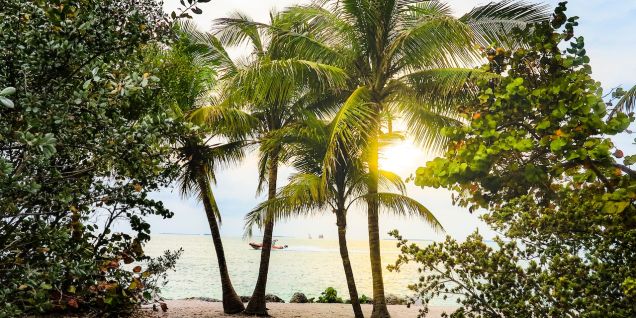A Guide On The Best Time To Visit Florida Weather-Wise


Step into a world of sun-soaked enchantment as we unveil the magical moments to explore Florida. This meticulously curated guide will lead you through a kaleidoscope of weather patterns, unearthing the perfect time to bask in Florida's sun-kissed beaches, lush tropical landscapes, and thrilling theme parks.
Prepare to embark on a meteorological adventure tailored to help you seize the quintessential Floridian experience infused with azure skies and the warmth of golden sands. Let the journey begin!
Florida's Winter Season (December to February) offers a refreshing respite from frigid northern climates. With temperate weather hovering between the mid-50s and low 70s, it's an idyllic time for outdoor enthusiasts to indulge in hiking, cycling, and golfing. Moreover, this period presents a unique opportunity to explore the state's iconic theme parks, minus the bustling summer throngs.
What is the biggest advantage of visiting during this time of year? You can enjoy some of Florida's best attractions at reduced prices because they're less crowded than usual. For example, Disney World will be more affordable since fewer people are traveling there during winter break (and if you want to go after Christmas or New Year's Eve).
Spring is a great time to visit Florida. The weather is warm but not too hot; you can enjoy the outdoors without being sweltering in the heat.
Mild temperatures and plenty of precipitation characterize Springtime in Florida. Average temperatures range between 65 and 75 degrees Fahrenheit (18-24 Celsius), with highs reaching 80 F (26 C) occasionally. Precipitation averages around 2 inches per month during this season--enough rain to keep everything green but not so much that you'll get soaked if you go outside without an umbrella!
Spring has its advantages: it's cooler than summer but warmer than winter; there aren't many bugs around yet; crowds are small because it isn't peak tourist season yet; hotels are cheaper because fewer people are traveling due to school schedules being out or businesses being closed for spring break etc... However there are also some disadvantages: mosquitoes will out so bring bug spray!
Summer is the best time to visit Florida. The weather is warm and sunny, with temperatures ranging from the mid-70s to mid-90s. This season offers plenty of outdoor activities such as snorkeling, sailing, and water sports. During this time of year, you can also explore the state's cultural attractions, like museums or theme parks.
READ MORE: 10 Affordable Summer Vacation Ideas for Families
Fall is the best time to visit Florida weather-wise. The temperatures are mild, the crowds have thinned out, and you can enjoy all these beautiful state offers without sweating or shivering.
Fall is also a great time for outdoor activities such as hiking, biking, and kayaking. You'll find plenty of sunshine this season, but it's not too hot yet so you won't need sunscreen or bug spray!
The only disadvantage of visiting during the fall is that some attractions may be closed due to low visitor numbers (they want people who will pay admission fees).
The hurricane season in Florida, which extends from June through November, is characterized by an increased occurrence of tropical storms and hurricanes. While this period may seem daunting to potential visitors, having an enjoyable experience in the Sunshine State is still possible, provided that you take certain precautions and stay informed.
Although the probability of a hurricane directly affecting your trip is relatively low, it is essential to be prepared in case of such an event. Keep an eye on the local weather forecasts and news channels, and adhere to any evacuation orders if issued. Investing in travel insurance that includes coverage for hurricane-related disruptions is also wise.
Interestingly, the hurricane season offers its own set of benefits for travelers. Owing to the lower demand, many tourist attractions and accommodations are less crowded and more affordable during this time. Furthermore, the weather remains predominantly warm and sunny, making it suitable for outdoor adventures and beach visits.
It is important to note that the intensity of the hurricane season fluctuates from one year to another. Some years witness minimal storm activity, while others may see multiple hurricanes. By staying vigilant and well-prepared, you can make the most of Florida's diverse offerings during this dynamic and unique period.
If you plan on visiting Florida, the best time to visit weather-wise is between November and April. This is when the weather is mild and warm, with minimal rain. The summer months are hot and humid and prone to frequent thunderstorms and hurricanes in July and August. If you want to avoid these conditions, plan your trip for early fall or late spring instead.
The summer season (June to August) is ideal for beach activities, thanks to warm temperatures and sunny weather.
Manatees are most commonly spotted during spring (March to May) as they migrate to warmer waters.
Visiting theme parks during the winter (December to February) typically results in fewer crowds and shorter wait times.
Popular
6 Affordable Makeup Organizers To Declutter Your Vanity
For the makeup lovers! Here are the best 6 Affordable Makeup Organizers To Declutter Your Vanity.
Look at the Stunning Debut of Alia Bhatt at the Met Gala 2023
Alia Bhatt Met Gala 2023 debut was a huge success, and she certainly made a mark with her stunning look. Now grab for more details here!
Crunches Vs. Sit-Ups: Which One Is Best For Your Abs?
Exercises that burn fat can help you lose weight .If you want to know Crunches Vs. Sit-ups: Which one is best for your Abs read below
Black Seed Oil Benefits For Hair and Skin
Black seed oil offers a wide range of benefits for hair and skin. Now get more information about black seed oil visit the blog!
